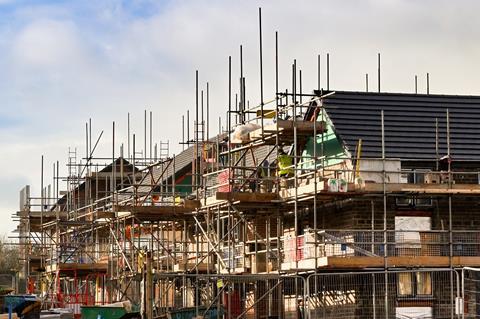From land banking to a probe into anti-competitive activity, we breakdown the critical points from the UK competition regulator’s report into the housebuilding market
Today saw the publication of a year-long investigation by the Competition Markets Authority (CMA) into the state of the housebuilding industry in England, Scotland and Wales. The report concluded that “the housebuilding market is not delivering well for consumers and has consistently failed to do so over successive decades”.

It also uncovered alleged breaches of the Competition Act by eight UK housebuilders and a subsequent inquiry has been launched into whether or not they shared sensitive information.
What’s the background?
The CMA launched its study into housebuilding in England, Scotland and Wales on February 28 last year in response to a formal request from housing secretary Michael Gove.
Gove wrote to the CMA requesting a study into the housebuilding sector, highlighting the importance of ensuring that the market is working in the best interests of consumers. This followed comments in which Gove had accused housebuilders of operating like a “cartel”.
The report published this morning includes a series of findings and recommendations.
Housebuilders are not hoarding land
One positive feature of today’s report is the recognition that housebuilders are not unnecessarily land banking.
The report points out that 1.1 million plots of land are being held by the 11 biggest UK housebuilders and that land banks of major builders have expanded over the past decade.
However, in investigating the causes of land banking, the report finds that land banking practices are not unreasonable. The report seems to suggest the practice of land banking is perfectly rational given the length of time that it takes things to get through the planning system.
in its interim industry report, the CMA warned it would clamp down on land banking.
Rather than suggesting the land banking is a deliberate tactic being used by housebuilders, the CMA’s report describes land banking as a symptom “of the time and uncertainty associated with obtaining planning permission”.
It also found that while SME housebuilders may face some disadvantages in being able to secure land, and that while larger housebuilders hold large amounts of land, this practice does not “distort the market” which remains “competitive.”
Planning reform is top of the agenda
There was some suggestion from analysts when the CMA first launched its report last February that Gove was trying to steer the researchers away from focusing on planning.
In its initial scope for the report, the CMA said it would examine “structural and behavioural barriers to the market working well and the implications of these for customers, rather than fundamental aspects of the planning regime or government policy.”
Today’s CMA report is clear, however, that the biggest culprit in preventing the delivery of new homes is indeed planning. The report specifically highlights the need for local plans to be put in place by local authorities.
More than 65 local authorities have now withdrawn their local plans since Gove announced reforms to the National Planning Policy Framework last year.
The CMA report found that “the planning system is exerting a significant downward pressure on the overall number of planning permissions being granted across Great Britain”.
It said over the long term the volume of permissions given has been “insufficient to support housebuilding at the level required to meet government targets and […] assessed need”.
The report also finds that there is a “disproportionate impact on SME housebuilders”.
Steve Turner, executive director of the Home Builders Federation, said: “The CMA report recognises the challenges the industry faces when looking to deliver homes.
“We welcome recognition that the planning system is a fundamental barrier to delivery and adds unnecessary delay and cost into the development process, and the need for local authorities to have plans in place and properly resourced planning departments.
Trend towards estate management fees
The report found that 80% of new houses being built by the largest housebuilders charge estate management fees.
��ɫ����TV understands that some of the information shared as part of the report research included letters to residents in management fee arrears threatening to repossess their homes.
The report reveals the estate management model had a detrimental impact on residents, both financially and psychologically. It uncovered evidence that such fees were often high and unclear to homeowners.
The average charge was £350, but one-off, unplanned charges for significant repairs could cost thousands.
The report highlights concerns that many homeowners are unable to switch estate management providers, received inadequate information upfront and had to deal with shoddy or unsatisfactory maintenance.
It adds that residents can face unclear administration or management charges which can often make up 50% or more of the total bill.
A source close to the CMA report told ��ɫ����TV that “the imbalance of power” in examples of agency management fees, were comparable to those of leaseholders.
‘Anti-competitive’ probe could take a long time
As part of the study, the regulator said it had found evidence indicating alleged breaches of competition law by eight UK housebuilders. Barratt, Bellway, Berkeley, Bloor Homes, Persimmon, Redrow, Taylor Wimpey and Vistry stand accused of sharing “commercially sensitive information”.
A probe has been launched to investigate if any of the above have broken the law.
Market studies, such as the one the CMA published today, have a statutory timeframe of 12 months. Competition Act investigations, by contrast, do not have statutory time restrictions.
��ɫ����TV understands that the investigation into the eight accused housebuilders could take “quite a while” This is because the investigations are of a serious nature, with serious penalties if they are proven.
The accused housebuilders were issued with notifications regarding the investigations this morning and the CMA will be requesting further information and cooperation from them.
The CMA will be investigating whether the eight accused housebuilders have been “sharing non-public information on sales prices, incentives, and rates of sale”.
It adds: “The sharing of commercially sensitive information has the potential to weaken competition between housebuilders by reducing strategic uncertainty in the market and influencing housebuilders’ commercial decisions, including on output or prices.”
The purely speculative model is not working
If government building targets are to be met, then there needs to be a greater focus on the delivery of non-speculative housing, the report suggests. It reveals that around 60% of homes built in 2021 to 2022 were delivered by speculative private development.
It defines speculative development as “when builders obtain land, secure planning permission, and construct homes without knowing in advance who will buy them or for how much.”
The CMA found the largest 11 housebuilders provided around 40% of homes in 2021-22, the majority of which were through the speculative model.
England builds a higher proportion of speculative housing, and Scotland and Wales have a higher proportion of affordable housing.
The report points out that there were fewer than 250,000 homes built last year across England, Scotland and Wales, falling well below the 300,000-homes target for England alone.

Around a third of homes, meanwhile, are built on an affordable housing basis, meaning they are sold or rented at a discount to market price.
The CMA report found that England builds a higher proportion of speculative housing, and Scotland and Wales have a higher proportion of affordable housing.
The report’s findings suggests the dominance of a speculative model, based on build-out rates and profitability, rather than building homes based on assessed needs in areas where housing might be cheaper, is not enough to help any of the three nations hit government housing targets.
Housebuilder profitability is ‘better than expected’
Margins and profitability have been huge discussion points in the industry lately, with major firms from Stewart Milne to Inland Homes collapsing. But the CMA report says the profitability of the 11 largest housebuilders is “generally higher than we would expect”.
It points out that profits in the period from 2013 to 2019 were particularly high.
The report adds however that the housing market is highly cyclical and impacted by external factors, including the wider economic climate. It says that profitability during the 2010s is likely to have been boosted by supportive economic circumstances and government-back incentive schemes such as Help to Buy.
No incentive to boost build-out rates
Whether or not the eight firms under scrutiny from the CMA have been sharing sensitive information, the CMA found evidence that builders tend to build homes at a rate which they can sell them without needing to reduce their prices.
It is arguable that building in line with local absorption rates is simply good business, but the report suggests that instead of building homes as quickly as possible, housebuilders construct them at a rate that they will be able to sell them.
The CMA highlights that the extent to which housebuilders can expand their supply in a local area is inherently limited by the extent to which they can get hold of further land with planning permission in the area.
It says: “Given that it is costly for housebuilders to have capital tied up in partly finished or finished, unsold homes, they are incentivised to control their build-out rate to a level that maintains selling prices.”


























No comments yet